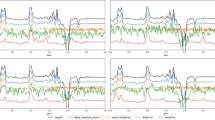Abstract
With diffusion tensor imaging (DTI), more exquisite information on tissue microstructure is provided for medical image processing. In this paper, we present a locally adaptive topology preserving method for DTI registration on Lie groups. The method aims to obtain more plausible diffeomorphisms for spatial transformations via accurate approximation for the local tangent space on the Lie group manifold. In order to capture an exact geometric structure of the Lie group, the local linear approximation is efficiently optimized by using the adaptive selection of the local neighborhood sizes on the given set of data points. Furthermore, numerical comparative experiments are conducted on both synthetic data and real DTI data to demonstrate that the proposed method yields a higher degree of topology preservation on a dense deformation tensor field while improving the registration accuracy.









Similar content being viewed by others
References
Pierpaoli, C., Jezzard, P., Basser, P.J., Barnett, A., Di Chiro, G.: Diffusion tensor mr imaging of the human brain. Radiology 201(3), 637–648 (1996)
Alexander, D.C., Gee, J.C.: Elastic matching of diffusion tensor images. Comput. Vis. Image Underst. 77(2), 233–250 (2000)
Zhang, H., Yushkevich, P.A., Alexander, D.C., Gee, J.C.: Deformable registration of diffusion tensor mr images with explicit orientation optimization. Med. Image Anal. 10(5), 764–785 (2006)
Guimond, A., Guttmann, C.R., Warfield, S.K., Westin, C.-F.: Deformable registration of dt-mri data based on transformation invariant tensor characteristics. In: Biomedical Imaging, 2002. Proceedings. 2002 IEEE International Symposium on, pp. 761–764. IEEE (2002)
Vercauteren, T., Pennec, X., Perchant, A., Ayache, N.: Diffeomorphic demons: efficient non-parametric image registration. NeuroImage 45(1), S61–S72 (2009)
Cao, Y., Miller, M., Mori, S., Winslow, R.L., Younes, L., et al.: Diffeomorphic matching of diffusion tensor images. In: Computer vision and pattern recognition workshop, 2006. CVPRW’06. Conference on, pp. 67–67. IEEE (2006)
Yeo, B.T., Vercauteren, T., Fillard, P., Pennec, X., Golland, P., Ayache, N., Clatz, O.: Dti registration with exact finite-strain differential. In: Biomedical imaging: from nano to macro, 2008. ISBI 2008. 5th IEEE International Symposium on, pp. 700–703. IEEE (2008)
Vercauteren, T., Pennec, X., Perchant, A., Ayache, N.: Non-parametric diffeomorphic image registration with the demons algorithm. Med. Image Comput. Comput. Assist. Interv. MICCAI 2007, 319–326 (2007)
Sweet, A., Pennec, X.: Log-domain diffeomorphic registration of diffusion tensor images. In: Biomedical image registration, pp. 198–209. Springer (2010)
Zhang, Z., Wang, J., Zha, H.: Adaptive manifold learning. Pattern Anal. Mach. Intell. IEEE Trans. 34(2), 253–265 (2012)
Arsigny, V.: Processing data in lie groups: an algebraic approach. application to non-linear registration and diffusion tensor mri. PhD thesis, Ecole Polytechnique X (2006)
Roweis, S.T., Saul, L.K.: Nonlinear dimensionality reduction by locally linear embedding. Science 290(5500), 2323–2326 (2000)
Tenenbaum, J.B., De Silva, V., Langford, J.C.: A global geometric framework for nonlinear dimensionality reduction. Science 290(5500), 2319–2323 (2000)
Mahony, R., Manton, J.H.: The geometry of the newton method on non-compact lie groups. J. Glob. Optim. 23(3–4), 309–327 (2002)
Arsigny, V., Fillard, P., Pennec, X., Ayache, N.: Geometric means in a novel vector space structure on symmetric positive-definite matrices. SIAM J. Matrix Anal. Appl. 29(1), 328–347 (2007)
Arsigny, V., Commowick, O., Pennec, X., Ayache, N.: A log-euclidean framework for statistics on diffeomorphisms. In: Medical image computing and computer-assisted intervention–MICCAI 2006, pp. 924–931. Springer (2006)
Noblet, V., Heinrich, C., Heitz, F., Armspach, J.-P.: 3-D deformable image registration: a topology preservation scheme based on hierarchical deformation models and interval analysis optimization. Image Process. IEEE Trans. 14(5), 553–566 (2005)
Lin, X., Qiu, T., Morain-Nicolier, F., Ruan, S.: A topology preserving non-rigid registration algorithm with integration shape knowledge to segment brain subcortical structures from mri images. Pattern Recognit. 43(7), 2418–2427 (2010)
Zhang, Z., Zha, H.: Principal manifolds and nonlinear dimension reduction via local tangent space alignement. Department of computer science and engineering, Pennsylvania State University, Tech. Rep. CSE-02-019 (2002)
Vaillancourt, D., Spraker, M., Prodoehl, J., Abraham, I., Corcos, D., Zhou, X., Comella, C., Little, D.: High-resolution diffusion tensor imaging in the substantia nigra of de novo parkinson disease. Neurology 72(16), 1378–1384 (2009)
Woods, R.P., Grafton, S.T., Holmes, C.J., Cherry, S.R., Mazziotta, J.C.: Automated image registration: I. General methods and intrasubject, intramodality validation. J. Comput. Assist. Tomogr. 22(1), 139–152 (1998)
Jiang, H., van Zijl, P.C., Kim, J., Pearlson, G.D., Mori, S.: Dtistudio: resource program for diffusion tensor computation and fiber bundle tracking. Comput. Methods Programs Biomed. 81(2), 106–116 (2006)
Leemans, A., Sijbers, J., Verhoye, M., Van der Linden, A., Van Dyck, D.: Mathematical framework for simulating diffusion tensor mr neural fiber bundles. Magn. Reson. Med. 53(4), 944–953 (2005)
Hesselink, L., Levy, Y., Lavin, Y.: The topology of symmetric, second-order 3d tensor fields. Vis. Comput. Graph. IEEE Trans. 3(1), 1–11 (1997)
Barmpoutis, A., Vemuri, B.C., Shepherd, T.M., Forder, J.R.: Tensor splines for interpolation and approximation of dt-mri with applications to segmentation of isolated rat hippocampi. Med. Imaging IEEE Trans. 26(11), 1537–1546 (2007)
Jellison, B.J., Field, A.S., Medow, J., Lazar, M., Salamat, M.S., Alexander, A.L.: Diffusion tensor imaging of cerebral white matter: a pictorial review of physics, fiber tract anatomy, and tumor imaging patterns. Am. J. Neuroradiol. 25(3), 356–369 (2004)
Acknowledgments
This research is supported by the Sheng-Bu Industry-Academia-Research joint project of Education Ministry and Science & Technology Ministry of Guangdong Province (NO: 2012A090300001).
Author information
Authors and Affiliations
Corresponding author
Appendix
Appendix
Solution for cost function
Given the current transformation \(\varphi ^k\), compute a update \(\varphi ^{(k+1)}\) by minimizing
For convenience, let \(\Lambda (\varphi )=I_r-R(D_i)^\mathrm{T}\mathrm{log}(I_f\circ \varphi )R(D_i)\), we assume the linearization of \(\Lambda (\varphi )\) at a given point \(D_i\),
Equation (23) can be rewritten with the linearization in Eq. (24),
the normal equation can be expressed in matrix form as follows,
which simplies into,
solving for \(\varphi ^{(k+1)}\), we achieve,
where \(J(D_i)=-\bigtriangledown R(D_i)^\mathrm{T}\mathrm{log}(I_f\circ \varphi ^k)R(D_i)\) and \(R(D_i)=((J(D_i)J(D_i)^T)^{-\frac{1}{2}})J(D_i)\).
Finally, we can obtain the optimization solution by the Gauss–Newton iteration,
Rights and permissions
About this article
Cite this article
Liu, W., Chen, L., Cai, H. et al. Adaptive registration of diffusion tensor images on lie groups. Opt Rev 23, 614–627 (2016). https://doi.org/10.1007/s10043-016-0231-9
Received:
Accepted:
Published:
Issue Date:
DOI: https://doi.org/10.1007/s10043-016-0231-9




